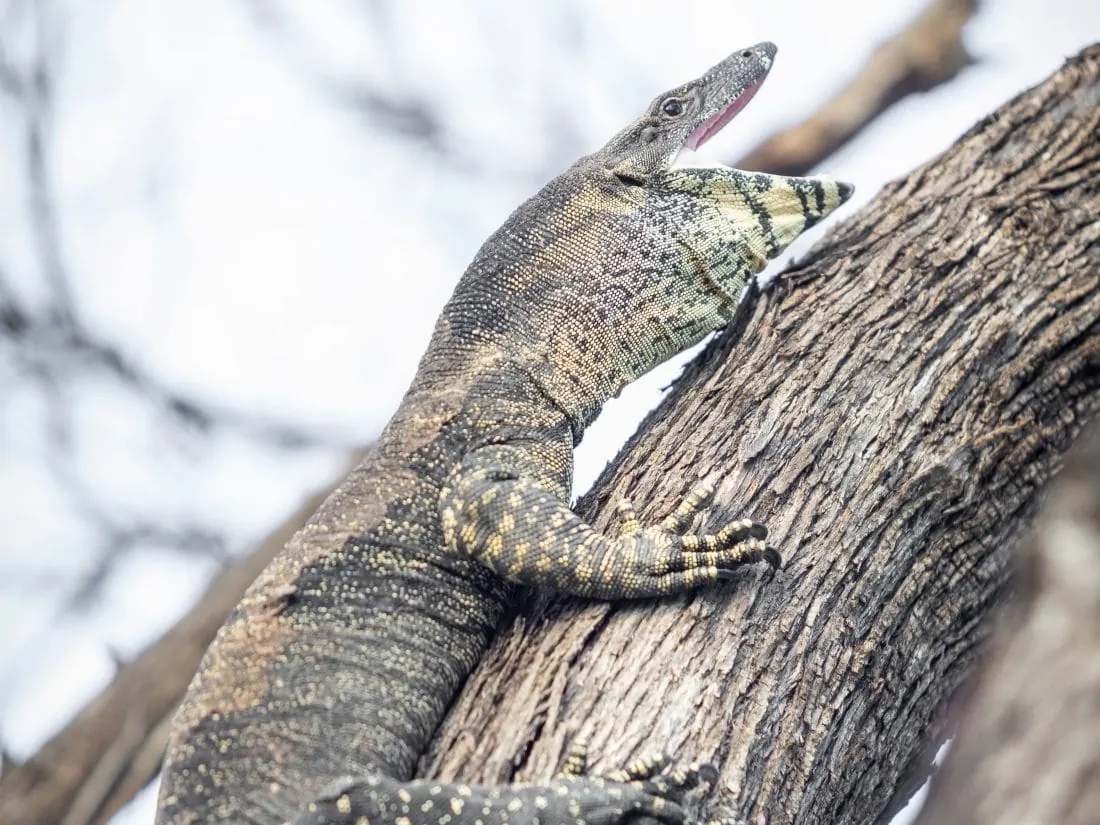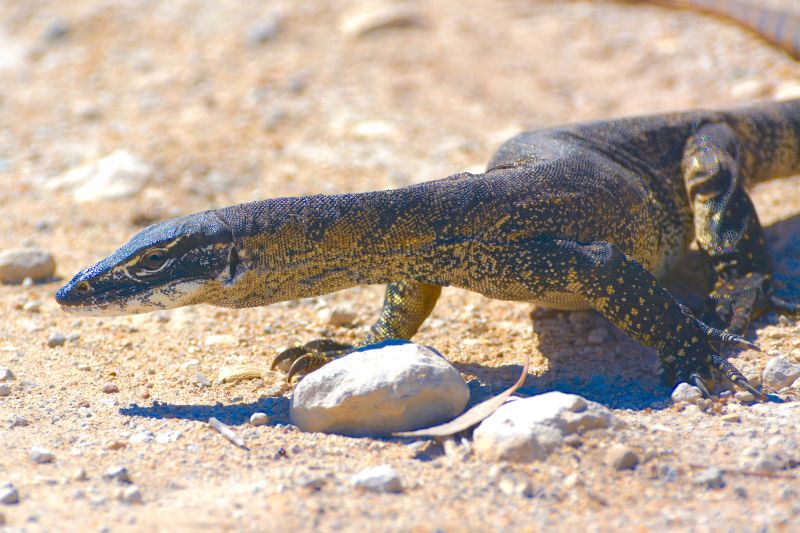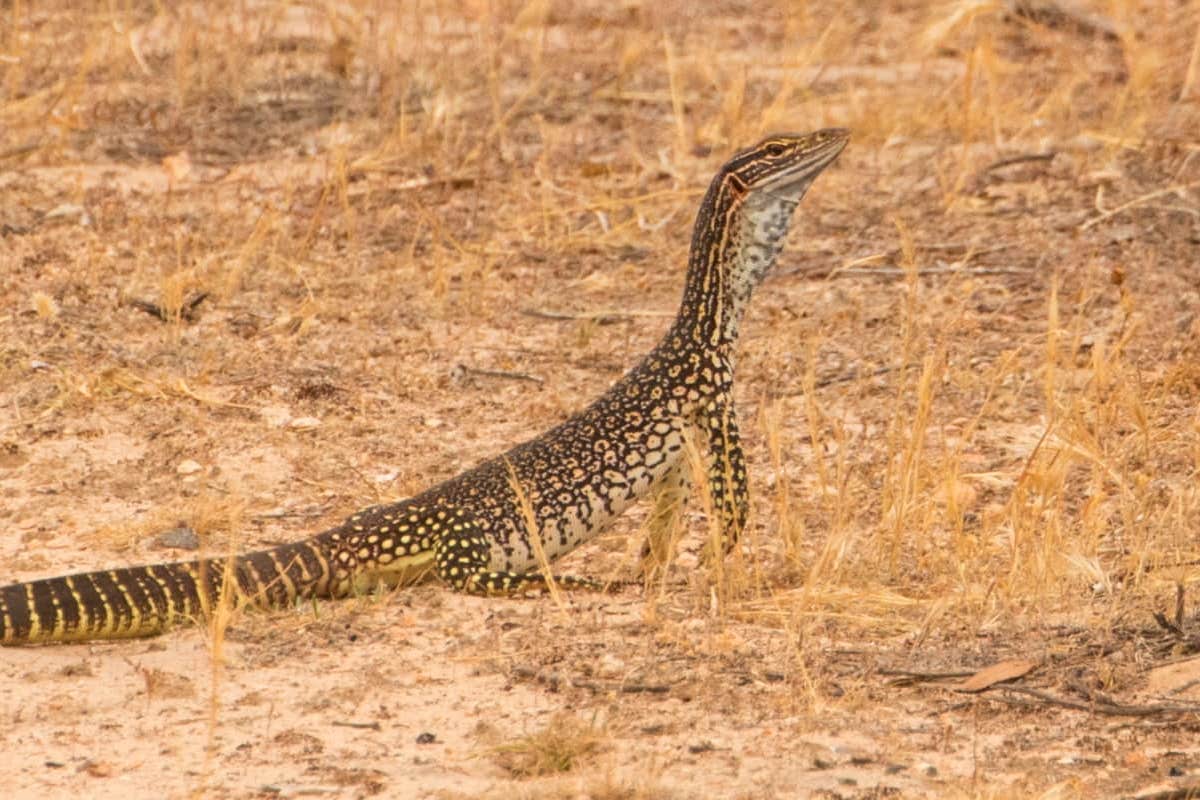Australia is home to a remarkable group of reptiles known as goannas, or monitor lizards, belonging to the genus Varanus. These large, carnivorous lizards first arrived from the north during the Miocene epoch, around 15 million years ago. With 27 extant species across the continent today, goannas play an important role in both the natural world and cultural heritage.
Goannas are often seen basking in the sun, climbing trees, or darting across the landscape on powerful limbs. They are survivors of an ancient lineage, having changed little in body form since their ancestors roamed with dinosaurs. From forest canopies to arid deserts and tropical waterways, they've adapted to thrive in a huge variety of Australian habitats.
Cultural and Ecological Importance
Goannas feature heavily in Aboriginal Dreamtime stories, reflecting their long-standing role in the lives of First Nations Australians. They were and still are an important bush food in some regions and have been observed and understood for generations.
Ecologically, goannas help control populations of insects, rodents, and other small animals. As scavengers, they also reduce disease by consuming carrion. Their presence indicates a healthy ecosystem, and their loss can have cascading effects on biodiversity.
Size and appearance
Goannas vary dramatically in size. At the top end is the mighty Perentie (Varanus giganteus), Australia's largest lizard, growing over 2 metres long. At the other end of the scale is the Short-tailed Monitor (Varanus brevicauda), measuring just 20–25 cm in length.
Species such as the Lace Monitor (Varanus varius) and Rosenberg's Goanna (Varanus rosenbergi) are easily identified by their striking patterns of black, yellow, or white speckles and bands, which provide camouflage in forests and scrub. Desert-dwelling species like the Sand Goanna (Varanus gouldii) tend to have orange or light brown hues.
Most goannas have strong claws, long tails, and keen eyesight. Many, like the Lace Monitor, are excellent climbers, while Merten's Water Monitor (Varanus mertensi) is highly aquatic, with adaptations for swimming.
Diet
Goannas are opportunistic carnivores. Their diet depends on their size and environment but generally includes insects, smaller reptiles, birds, mammals, and eggs. In tropical northern Australia, some even raid crocodile nests for eggs.
They also scavenge carrion and are drawn to rotting meat, helping clean up the bush. Using their long, forked tongues, goannas detect chemical signals in the air, much like snakes, to locate prey.
Their varied hunting styles, including tree-climbing, digging, sprinting, and swimming, reflect their diverse habitats and roles as both predators and scavengers.

Lace Monitor along the Murray River. Image: Murray River Trails.
Breeding
Goannas generally dig burrows to lay their eggs, but some species have developed remarkable nesting strategies. Lace Monitors and Rosenberg's Goannas lay eggs in termite mounds. The termites then reseal the mound, maintaining a stable temperature and protecting the eggs from predators.
In an extraordinary display of parental care, female Lace Monitors are known to return when the young hatch to dig them out – a rare behaviour among reptiles.
Mating typically occurs in spring and summer, with females laying anywhere from 6 to 30 eggs, depending on the species. In colder regions, some goannas hibernate during winter months.
Conservation
While many goannas remain widespread, several species are under threat from a combination of pressures:
- Habitat loss and degradation, especially from land clearing, has reduced available nesting and hunting grounds.
- Cane Toads pose a significant threat. Many goannas die after eating them, as they cannot tolerate the toad's toxins.
- Invasive predators, such as foxes and cats, can prey on juvenile goannas or compete for food.
- The destruction of termite mounds, fallen logs, and other natural features can directly impact reproductive success.

A Rosenberg's Goanna on the Eyre Peninsula. Image: Australian Coastal Safaris
Where to see goannas in the wild
Want to see one in the wild? Join a local wildlife tour for your best chance:
East Gippsland, Victoria
Species: Lace Monitor
East Gippsland's diverse eucalypt forests and temperate rainforests offer ideal habitat for the Lace Monitor, often seen basking on tree trunks or foraging near fallen logs. This region's protected reserves and national parks provide excellent opportunities for spotting these strikingly patterned, tree-loving goannas.
Featured tour: East Gippsland Wildlife Journey
Operator: Echidna Walkabout Nature Tours
Duration: 4 days
This four-day tour explores East Gippsland's magnificent lush rainforests, coastal heathlands, giant eucalypt groves, white sandy beaches and pristine rivers and estuaries, offering you encounters with an incredible array of species including Eastern Grey Kangaroos, koalas, gliders, wallabies, Lace Monitors, Short-beaked Echidnas and an array of birds such as King Parrots, Eastern Whipbirds, and the fascinating Superb Lyrebird.
Mungo National Park, New South Wales
Species: Sand Goanna, Lace Monitor
The ancient dunes and dry lakebeds of Mungo National Park create perfect conditions for Sand Goannas, known for their speed and agility, while the Lace Monitor is often found in the woodland fringes. The park's open terrain offers good visibility, making sightings more likely on warm, sunny days
Featured tour: Private Mungo Outback Journey
Operator: Echidna Walkabout Nature Tours
Duration: 4 days
Be captivated by the expansive red sand plains and dunes, riverine ecosystems of the famous Murray and Darling Rivers and the arid land ecosystems around Lake Mungo. Spot Red Kangaroos, Western Grey Kangaroos, Emus, Pink Cockatoos, several parrot species including Mulga, Red-rumped, Mallee Ringnecks and Blue-bonnets, raptor birds including the Wedge-tailed Eagle and several species of lizard basking in the sun.
Riverland, South Australia
Species: Lace Monitor
Stretching across several states, the Murray River region is home to large riparian woodlands and red gum forests - a haven for Lace Monitors. Look for them sunning themselves on logs or making their way up tree trunks near riverbanks.
Featured tour: Murray River Safari
Operator: Murray River Trails
Duration: 4 days
Experience the diverse wildlife offerings where Australia's river oasis meets the outback. This multi-activity wildlife safari along Australia's greatest river includes guided walks, canoeing, an outback drive and open back cruising, combined with luxurious houseboat accommodation and superb dining including local wines. Spot Koalas, Kangaroos, Australian Pelicans, Royal Spoonbills, Black Swans and Darters from the comfort of a private pontoon cruiser. Canoe through tranquil backwaters teeming with birdlife, including ducks, darters, cormorants, kites and parrots, along with the opportunity to spot Western Grey Kangaroos and Lace Monitors.
Kangaroo Island, South Australia
Species: Rosenberg's Goanna
Rosenberg's Goanna, or the Heath Monitor, thrives in the dense heathlands and mallee scrub of Kangaroo Island. Their nesting behaviour in termite mounds makes them fascinating to observe for patient wildlife watchers.
Featured tour: Kangaroo Island In Style
Operator: Exceptional Kangaroo Island
Duration: 2 days
Discover what makes Kangaroo Island such a celebrated region, as you experience the Island's history, ecology, landscape, contemporary lifestyle, regional produce and incredible wildlife offerings. Key species regularly encountered are Koalas, Tammar Wallabies, Kangaroo Island Kangaroos, endangered Glossy Black Cockatoos, Short-beaked Echidnas, Australian Sea-lions, Long-nosed Fur-seals, Rosenberg's Goanna (warmer months) and a variety of bush birds, shorebirds and seabirds.
Eyre Peninsula, South Australia
Species: Rosenberg's Goanna
With its rugged coastlines and undisturbed bushland, the Eyre Peninsula supports healthy populations of Rosenberg's Goannas. Keep an eye out on walking trails through Lincoln and Coffin Bay national parks, where they are most active during spring and summer.
Featured tour: Port Lincoln Wildlife Encounters
Operator: Australian Coastal Safaris
Duration: 2 days
This incredible two day adventure combines the best terrestrial and marine protected areas across the region including Lincoln National Park, Coffin Bay National Park, Big Swamp, Mikkira Station and Mount Dutton Bay Conservation Park. There is an abundance of seabirds, shorebirds, songbirds, parrots (including the beautiful Port Lincoln Parrot) and raptors including Osprey and White-bellied Sea Eagles, with Western Grey Kangaroos, Emus, Koalas and Rosenberg's Goannas a delight for visitors travelling from around the globe.
Cairns & Daintree, Queensland
Species: Yellow-spotted Monitor
The open woodlands, floodplains, and savannas of Far North Queensland are home to the Yellow-spotted Monitor, one of Australia's most powerful terrestrial goannas. Often called the Argus Monitor, this species is highly active and alert, using its speed and sharp senses to hunt small mammals, reptiles, and carrion. Look for them during the day, especially after rain, when prey is more abundant.
Featured tour: 4 Day Ultimate Wildlife
Operator: FNQ Nature Tours
Duration: 4 days
Far North Queensland is a wildlife enthusiast's paradise with this small group tour concentrating on the endemic wildlife found within Australia's most biodiverse region.
Exmouth, Western Australia
Species: Perentie
The arid ranges and open plains around Exmouth and the Cape Range National Park are prime territory for the Perentie, Australia's largest goanna. Spotting one is a memorable experience - they're powerful, elusive, and often seen sunning themselves on rocky outcrops, making their way across the red earth, or even venturing into town!
Featured tour: Deluxe Megafauna Swim*
Operator: Exmouth Dive & Whalesharks Ningaloo
Duration: Full day
Experience a snorkel on the beautiful Ningaloo Reef before heading out to swim with either the majestic Humpback Whale or the world's largest fish, the Whale Shark.
*Clearly, you aren't going to see a Perentie on this tour. But keep an eye out while in the township of Exmouth - they've been known to pass by...
FAQs
Are goannas dangerous to humans?
Goannas are generally shy and avoid human contact. They are not aggressive unless cornered or provoked. While their claws and teeth can cause injury if they feel threatened, bites are rare. It's best to observe them from a respectful distance.
Do goannas have venom?
Yes – some species, like the Lace Monitor, have mild venom in their saliva that can help subdue prey and may cause local swelling or irritation in humans. However, it's not dangerous and is quite different from snake venom.
How fast can goannas run?
Surprisingly fast! Larger species like the Sand Goanna can reach speeds of up to 40 km/h in short bursts. They use this speed to catch prey or escape predators.
Do goannas hibernate?
In southern Australia, some goannas go through a period of torpor or hibernation during the colder months, staying in burrows or hollow logs until temperatures rise again.

Sand Goanna in Mungo National Park. Image: Echidna Walkabout Nature Tours

